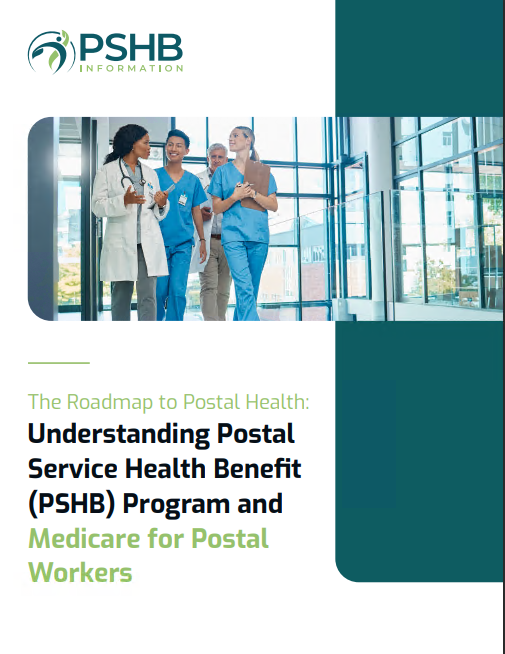Key Takeaways:
-
Combining Medicare with PSHB coverage in 2025 can significantly reduce out-of-pocket healthcare expenses, including prescription drug costs.
-
Understanding how Medicare integrates with PSHB plans is essential for maximizing your benefits and ensuring comprehensive coverage.
Why Medicare and PSHB Make a Perfect Pair
As a Postal Service employee or annuitant, you already have access to the Postal Service Health Benefits (PSHB) program. But if you’re Medicare-eligible, combining Medicare with your PSHB plan can open the door to even greater savings and enhanced coverage. Let’s unpack how these programs complement each other to give you more value and peace of mind.
How Medicare Part B Enhances Your PSHB Plan
One of the biggest advantages of integrating Medicare with PSHB is the added benefits Medicare Part B offers. If you’re 65 or older, or otherwise Medicare-eligible, enrolling in Part B alongside your PSHB plan gives you access to reduced deductibles, lower copayments, and improved cost-sharing for various medical services.
Lower Cost Sharing
Many PSHB plans waive or reduce deductibles and copayments when you’re also enrolled in Medicare Part B. For example, routine visits to primary care doctors and specialists often become more affordable, with some copayments reduced significantly.
Coordinated Coverage
Medicare Part B becomes your primary payer for outpatient services, such as doctor visits, diagnostic tests, and preventive care. PSHB acts as a secondary payer, picking up costs Medicare doesn’t cover, like copayments and coinsurance. This coordination ensures that your out-of-pocket costs are minimized.
Prescription Drug Savings: A Game-Changer for 2025
Prescription drug costs are a significant expense for many retirees. Fortunately, 2025 brings a major change: the introduction of a $2,000 annual cap on out-of-pocket costs for Medicare Part D, which also applies to PSHB enrollees through Medicare’s Employer Group Waiver Plans (EGWPs). This cap eliminates the dreaded “donut hole” coverage gap and makes managing prescription expenses more predictable.
How It Works
If you’re enrolled in both Medicare and a PSHB plan, your prescription drug benefits will likely be coordinated through an EGWP. This means you’ll enjoy:
-
Lower copayments for generic and brand-name drugs.
-
Protection against high medication costs once you hit the $2,000 cap.
-
The option to spread costs over monthly payments with the Medicare Prescription Payment Plan.
Preventive Medications
Many PSHB plans offer additional savings on preventive medications for enrollees with Medicare. These can include discounted or waived copayments for drugs that manage chronic conditions like diabetes or high blood pressure.
Medicare’s Impact on Coinsurance and Deductibles
The integration of Medicare and PSHB doesn’t just stop at prescription drugs and routine visits. It’s also designed to ease the financial burden of coinsurance and deductibles for hospital and outpatient care.
Hospital Stays
Medicare Part A covers the bulk of hospital costs, including inpatient care, skilled nursing facilities, and some home health services. For PSHB enrollees, this means that your PSHB plan often steps in to pay coinsurance or additional hospital fees Medicare doesn’t fully cover. With Medicare, you can save hundreds or even thousands of dollars during extended hospital stays.
Outpatient Procedures
For outpatient surgeries or treatments, Medicare Part B typically covers 80% of the approved amount. Your PSHB plan then helps cover the remaining 20%, leaving you with little to no out-of-pocket expenses in most cases.
Why Medicare Enrollment Is Crucial for PSHB Benefits
Starting in 2025, Medicare enrollment becomes even more important for PSHB participants. Here’s why:
Mandatory Enrollment for Some Groups
If you’re a Postal Service retiree or an eligible family member who’s Medicare-eligible, you’re required to enroll in Medicare Part B to maintain PSHB coverage. Exceptions apply to those who retired before January 1, 2025, or employees aged 64 or older as of January 1, 2025.
Timing Matters
The best time to enroll in Medicare is during your Initial Enrollment Period (IEP), which begins three months before you turn 65 and ends three months after your 65th birthday. Delaying enrollment could result in penalties, increasing your Part B premium permanently.
Special Enrollment Periods
If you’re still working past age 65, you can delay Medicare enrollment without penalties. Once you retire, you’ll qualify for a Special Enrollment Period to sign up for Medicare Part B.
The Advantages of Medicare Part A
Medicare Part A is premium-free for most Postal Service retirees, provided you’ve paid Medicare taxes for at least 10 years. Even if you need to pay a premium, the benefits of enrolling often outweigh the costs.
What Part A Covers
-
Inpatient hospital care.
-
Skilled nursing facility care (up to 100 days).
-
Hospice care.
-
Some home health care services.
By combining Medicare Part A with your PSHB plan, you can enjoy nearly full coverage for hospital-related expenses, reducing your financial risk during unexpected health events.
Using Both Medicare and PSHB: Tips for Maximizing Your Benefits
To get the most out of your Medicare and PSHB plans, follow these tips:
1. Review Your Plan Options
Each PSHB plan offers unique benefits when integrated with Medicare. Use the Annual Open Season (October 15 to December 7) to compare plans and ensure you’re enrolled in one that suits your healthcare needs and budget.
2. Stay In-Network
Both Medicare and PSHB plans offer greater savings when you use in-network providers. Before scheduling appointments or procedures, confirm that your healthcare providers accept both Medicare and your PSHB plan.
3. Use Preventive Services
Medicare Part B fully covers many preventive services, such as annual wellness visits, screenings, and vaccinations. Combining these with PSHB benefits can help you catch health issues early, often at no additional cost.
4. Monitor Your Out-of-Pocket Spending
Keep track of your medical expenses to ensure you’re making the most of the $2,000 out-of-pocket cap for prescription drugs and reduced costs for other services.
What Happens if You Don’t Enroll in Medicare?
Skipping Medicare enrollment can have serious consequences for your healthcare coverage and costs:
Higher Out-of-Pocket Costs
Without Medicare, you’ll rely solely on your PSHB plan, which may mean higher deductibles, copayments, and coinsurance.
Coverage Limitations
Some PSHB benefits are only available if you’re enrolled in Medicare. Without it, you may miss out on valuable savings and enhanced coverage.
Potential Penalties
If you delay Medicare Part B enrollment, you’ll face a 10% penalty for each year you were eligible but didn’t enroll. This penalty is permanent and will increase your monthly premium.
Stay Ahead with Annual Plan Reviews
Healthcare needs change over time, and so do Medicare and PSHB plans. Conduct an annual review of your coverage to ensure it still meets your needs. Consider factors like premiums, deductibles, out-of-pocket caps, and covered services. Adjusting your plan during Open Season ensures you’re always getting the best value.
Why Medicare Makes PSHB Even Better
Combining Medicare with your PSHB plan unlocks a host of benefits: lower costs, broader coverage, and added financial protection. Whether it’s routine doctor visits, prescription medications, or hospital stays, Medicare integration simplifies your healthcare experience while saving you money. By staying informed and proactive, you can take full advantage of this powerful partnership.










